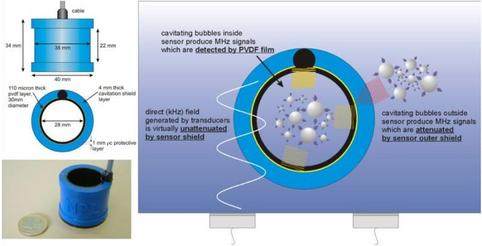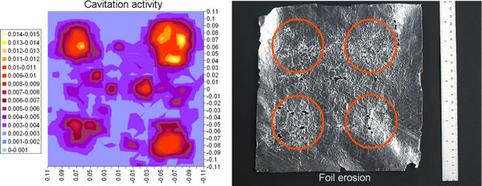Description:
The NPL
CaviMeter™ is the first instrument capable of measuring localised ultrasonic
cavitation (the implosion of bubbles in a liquid when a high frequency sound
wave is applied), and will transform the way in which hospitals clean medical
instruments , and the way in which manufacturers develop foodstuffs, biofuels
and pharmaceuticals, by providing a new measurement
capability.
The
CaviMeter’s key component is a novel spatially-sensitive sensor that detects
aultrasonic signals from acoustic cavitation activity in fluids. Coupled with a
bespoke electronics module, the NPL CaviMeter™, it provides a visual display of
real-time cavitation activity. The NPL CaviMeter provides a quick and simple to
use measurement solution for cleaning and sonoprocessing systems, and so is a
new and improved method of quality assurance.
Main
Features
By monitoring
the acoustic signals generated in fluids when clouds of bubbles implode under the
influence of an applied sound field, the CaviMeter identifies how much
cavitation is taking place at a given location, allowing 'hot-spots' and
'cold-spots' in cavitating systems to be identified. Manufacturers can use this
information for fine-tuning equipment to produce the ideal quantity and
distribution of cleaning or processing action.
Cavitation
sensor - Two principle features of the cavitation sensor contribute make it
novel. Collapsing cavitation bubbles generate very high frequency acoustic
signals and the Sensor includes a thin piezoelectric film that responds to these
signals. The shape of the Sensor, a hollow cylinder, combined with materials of
special acoustic properties, means that the signals can be associated with
specific volumes of liquid. This gives the sensor spatial resolution, allowing
it be used to map vessels.
Applications
Provide the
first direct measurement of the driving process behind ultrasonic cleaning,
sonochemistry and sonoprocessing;
Mapping
cavitation fields in ultrasonic cleaners, sonoprocessors, cell disruptors and
therapeutic medical ultrasound devices: this enables enhanced design assessment,
manufacturing tests and user QA;
As a diagnosis
tool for fault-finding problems in cavitation-producing
systems;
As an online
monitor for cleaning and sonoprocessing systems, providing accumulated ‘dose’
information for demonstrating conformance with local standards and regulatory
requirements
Developmental Status
Working
prototype system developed and end user tested
Availability
Demonstration
of system available
IP
Status
Available for
licensing (patents in UK, Germany, USA, Japan)
Technical
Responding to
the long-term industrial need for cavitation sensors of good temporal and
spatial resolution, NPL’s cavitation sensor is designed to detect the full
acoustic spectrum produced by a cavitating cloud. Its construction and operation
are shown below:
- 30mm high, 30mm internal diameter
- Acoustic emissions from bubbles detected using thin piezoelectric
material – 110 micron thick piezoelectric polymer, pvdf, giving a bandwidth up
to 11 MHz
- 4 mm thick blue polyurethane absorbing ‘shell’, which prevents
MHz signals generated outside the cylinder from being detected by the piezo film
- Perturbation of direct field produced by vessel (kHz) minimised
by using absorber material whose acoustic impedance is matched to that of water
- The 'measure' of inertial cavitation activity is the integrated
broadband power in the frequency band 1.5 - 7 MHz, which is determined using
spectral analysis or electronic filtering

Since initial
proof-of-concept, an extensive development and testing programme has been
completed, which has shown the sensor to have a broad frequency response and
strong spatial sensitivity. Recent studies in a commercial cleaning bath show
good correlations between the cavitation activity determined by the sensor
(left) and aluminium foil erosion (right):
